Indeed, the copper sink is a unique and fascinating metal with distinct characteristics. Its living finish and ability to develop a natural patina over time.
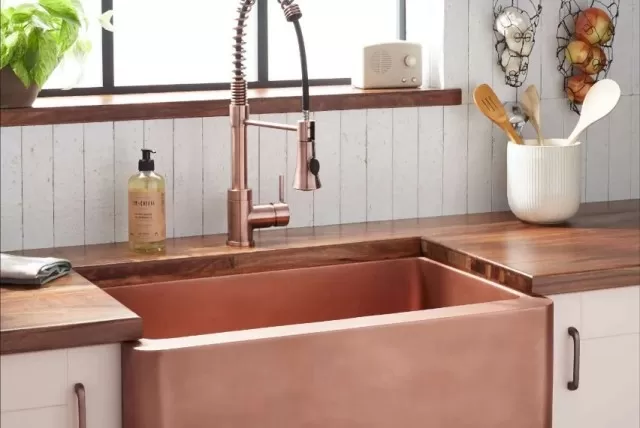
Its living finish and ability to develop a natural patina over time are part of its charm.
When it comes to copper sinks, they often undergo these changes more rapidly due to frequent use. This can include the development of a patina as well as spotting and stripping of the patina.
It’s important to note that these changes in the color and appearance of a copper sink should not be a cause for concern.
They are normal and do not indicate any damage to the sink. Instead, they reflect the inherent nature of copper.
Over time, the patina will continue to evolve, giving the copper sink a unique and aged character.
If desired, you can maintain the patina by following appropriate cleaning and maintenance practices specific to copper sinks.
However, it’s important to embrace and appreciate the natural changes that occur, as they contribute to the distinctive beauty of copper.
How Often to Clean a Copper Sink
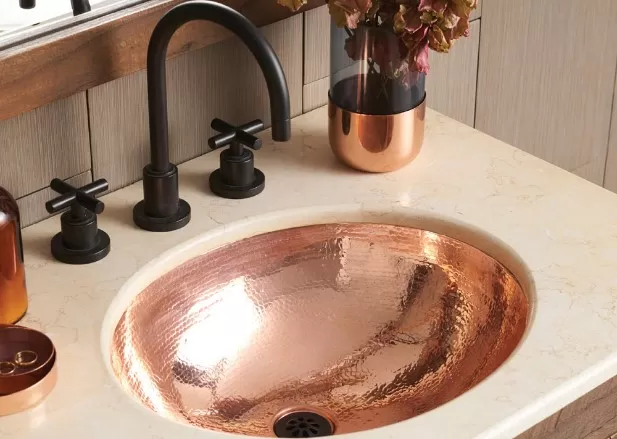
When it comes to maintaining the appearance of a copper sink, it is recommended to clean it frequently to keep it looking its best.
Cleaning a copper sink is a relatively easy task, similar to washing a dish. However, the frequency of cleaning can be a bit demanding.
Ideally, a copper sink should be cleaned daily.
This can be done using mild soap, warm water, and a soft cloth or sponge. Gently wiping the sink’s surface will help remove any dirt or grime that has accumulated throughout the day.
In addition to daily cleaning, it is also important to rinse the sink after each use to eliminate any acidic or oily residue that may affect the copper patina.
This step helps maintain the sink’s appearance and prevent any unwanted changes to the patina.
To prevent spotting caused by minerals present in the water supply, it is recommended to dry the sink after each use.
This will help avoid any water droplets from evaporating and leaving behind mineral deposits on the copper surface.
By incorporating these regular cleaning practices into your routine, you can keep your copper sink looking beautiful and well-maintained.
What to Avoid When You Clean a Copper Sink
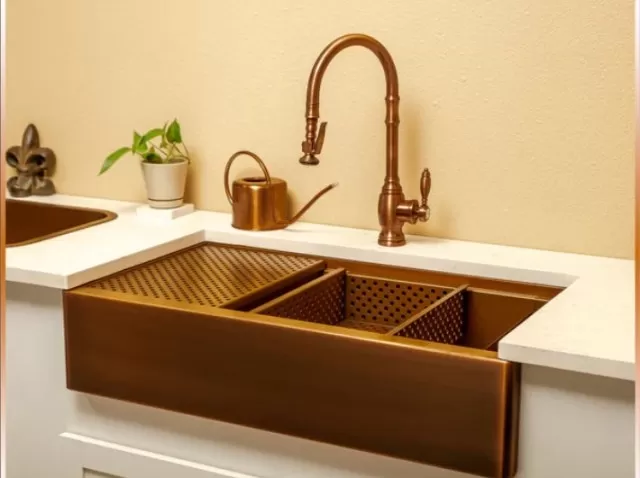
When it comes to cleaning a copper sink, it’s important to be aware of what should be avoided to prevent damage to the metal.
Here are some things to avoid when cleaning or caring for a copper sink:
Abrasive cleaners.
Avoid using scouring powders, cream cleansers, or any abrasive cleaners that can scratch the surface of the copper sink.
Chlorine bleach.
Steer clear of using chlorine bleach or any products that contain bleach as they can cause discoloration or damage to the copper.
Harsh chemicals.
Avoid using drain openers or other cleaning products that contain harsh chemicals.
These can potentially tarnish or corrode the copper surface.
Steel wool and abrasive scrubbing pads.
Do not use steel wool or abrasive scrubbing pads on a copper sink as they can scratch and damage the metal.
Leaving food or Dirty Dishes.
Avoid leaving food residue or dirty dishes in the sink, especially oily foods or acidic foods like tomatoes, lemons, or pickled vegetables.
These can potentially stain or etch the copper surface.
Residue from cosmetics and personal care products: Be cautious about leaving residue from cosmetics, toothpaste, shaving cream, or other personal care products in the sink.
These substances can leave stains or discoloration on the copper.
By avoiding these cleaning pitfalls and following proper cleaning techniques, you can help maintain the beauty and integrity of your copper sink.
Properly Clean a Copper Sink
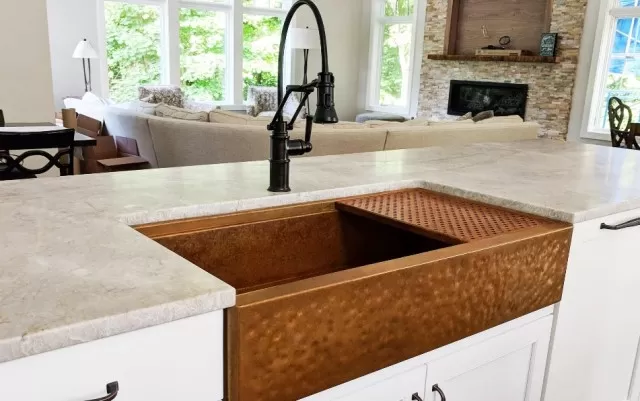
What You’ll Need.
- Mild Dish Soap
- Non-abrasive sponge or dishcloth
- Microfiber or cotton cloth
Instructions.
Step 1: Rinse the Sink.
Start by rinsing the sink with warm or hot water.
This will help remove any loose particles or residue from the surface of the sink.
Step 2: Wipe the Sink.
Take a mild liquid dish soap and apply it to a non-abrasive sponge or dishcloth.
Use the sponge or cloth to wipe the entire interior of the sink, including the sides and bottom. Pay extra attention to the rim of the sink, as food and liquids can often splatter and become trapped there.
Make sure to clean the entire surface to remove any dirt, grime, or stains.
Step 3: Rinse and Dry.
After cleaning the sink with the soapy solution, rinse it thoroughly with warm or hot water.
This will help remove any soap residue. Once rinsed, use a microfiber or cotton cloth to dry the sink and fixtures completely.
Drying is important to prevent water spots or mineral deposits from forming on the surface.
By following these steps regularly, you can keep your copper sink clean and maintain its appearance for years to come.
Common Troubles when Cleaning Copper Sink
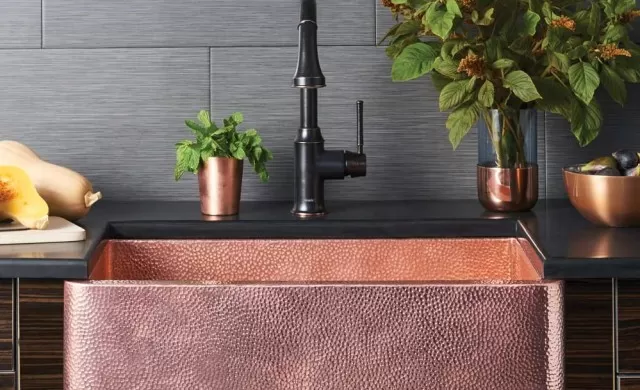
When encountering common problems with your copper sink, such as damage to the finish, bright spots, or green discoloration, here are some troubleshooting steps you can take.
Dishes or Food Damaging the Finish.
Use a bottom grid in your sink to keep dishes and utensils from directly touching the copper surface.
Use a sponge holder or tray to prevent Cleaning Tools, like sponges or dish wands, from coming in direct contact with the copper.
Bright Spots.
If bright spots occur due to exposure to acidic substances like lemon or tomato sauce, wipe away the substance.
Allow time for the patina to naturally redevelop.
The patina will darken and blend with the surrounding area.
To speed up the process, clean the sink with mild soap and water.
Use a stiff nylon bristle brush to gently scrub the edges of the bright spot, helping to wear away and blend the surrounding patina.
Green Spots or Discoloration (Verdigris).
Wipe the sink after each use to prevent water from pooling and soap residue from lingering on the surface.
Pay attention to areas like the drain and fixtures, where water tends to accumulate.
If verdigris occurs, simply wipe it off using a microfiber or cotton cloth.
If necessary, create a paste of baking soda and water and apply it to the copper using a sponge in a circular motion.
Rinse off the paste after scrubbing.
Remember that changes to the patina and occasional discoloration are part of the natural aging process of copper.
With proper care and maintenance, the rich tones of copper’s patina will reappear over time, enhancing the beauty of your sink.
*The information is for reference only.